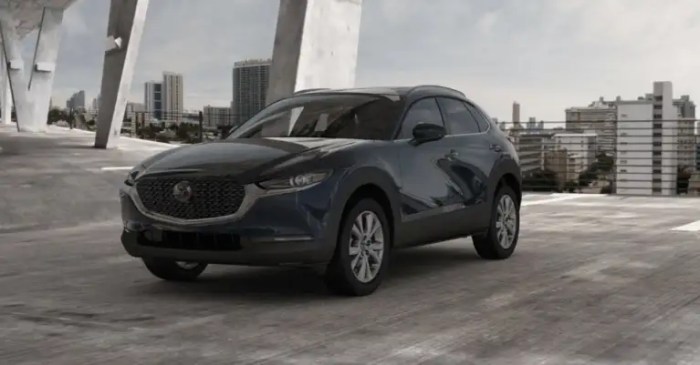Mazda CX-5 vs CX-30 Fuel Economy Compared
Mazda CX-5 vs Mazda CX-30 fuel economy – Choosing between the Mazda CX-5 and the Mazda CX-30 often comes down to individual needs and preferences. However, fuel efficiency is a significant factor for many buyers. This comprehensive comparison delves into the fuel economy of both vehicles, exploring various factors that influence their real-world performance and helping you make an informed decision. We’ll analyze EPA estimates, real-world driving experiences, engine options, and more to provide a clear picture of which SUV offers better gas mileage.
Understanding EPA Fuel Economy Estimates
The Environmental Protection Agency (EPA) provides estimated fuel economy figures for all new vehicles sold in the United States. These estimates are based on standardized testing procedures and are designed to give consumers a benchmark for comparison. However, it’s crucial to remember that real-world fuel economy can vary depending on several factors.
Mazda CX-5 Fuel Economy
The Mazda CX-5 offers a range of engine options, each impacting its fuel efficiency. Generally, you can expect the following EPA estimates (these may vary slightly depending on the model year and trim level):
- 2.5L 4-cylinder engine: Around 24 mpg city / 30 mpg highway / 27 mpg combined. This is a common engine option and provides a good balance of power and efficiency.
- 2.5L Turbocharged engine: Expect lower fuel economy with the turbocharged engine, typically around 22 mpg city / 27 mpg highway / 24 mpg combined. The increased power comes at the cost of slightly reduced fuel efficiency.
It’s important to note that all-wheel drive (AWD) versions of the CX-5 generally have slightly lower fuel economy ratings than their front-wheel drive (FWD) counterparts. Factors like tire pressure, driving style, and terrain also significantly affect real-world fuel consumption.
Mazda CX-30 Fuel Economy
The Mazda CX-30, being a smaller SUV, typically offers slightly better fuel economy than the CX-
5. The EPA estimates usually fall within these ranges (again, these may vary by model year and trim):
- 2.5L 4-cylinder engine: Around 25 mpg city / 33 mpg highway / 28 mpg combined. The smaller size and lighter weight contribute to the improved fuel efficiency compared to the CX-5.
Similar to the CX-5, AWD versions of the CX-30 will generally show slightly lower fuel economy figures. Remember that individual driving habits and conditions play a significant role in determining actual fuel consumption.
Factors Affecting Real-World Fuel Economy
While EPA estimates provide a helpful starting point, several factors can influence real-world fuel economy. Understanding these factors can help you manage your fuel consumption more effectively.
Driving Habits, Mazda CX-5 vs Mazda CX-30 fuel economy
Aggressive driving, including rapid acceleration and hard braking, significantly reduces fuel efficiency. Smooth, consistent driving is key to maximizing fuel economy in both the CX-5 and CX-30.
Terrain and Road Conditions
Driving in hilly or mountainous terrain, or on rough roads, requires more energy from the engine, leading to lower fuel economy. Similarly, driving in heavy traffic or stop-and-go conditions can also negatively impact fuel efficiency.
Vehicle Maintenance
Regular maintenance, including tire inflation checks, oil changes, and air filter replacements, is crucial for optimal engine performance and fuel efficiency. Neglecting maintenance can lead to reduced fuel economy and potential engine problems.
Payload and Cargo
Carrying heavy loads in either vehicle will reduce fuel economy. The extra weight puts more strain on the engine, requiring more fuel to maintain speed and acceleration.
Climate Control
Using the air conditioning or heater can impact fuel economy, especially in extreme temperatures. Try to use these systems sparingly when possible to improve fuel efficiency.
Engine Technology and Fuel Efficiency
Both the CX-5 and CX-30 utilize Mazda’s Skyactiv technology, which is designed to improve fuel efficiency and engine performance. However, the specific engine options and their associated technologies play a significant role in determining fuel economy.
Skyactiv-G Engine
The naturally aspirated 2.5L Skyactiv-G engine found in both vehicles is known for its relatively good fuel efficiency. Mazda’s focus on lightweight design and efficient combustion contributes to its performance.
Skyactiv-G 2.5T Engine (CX-5 Only)
The turbocharged 2.5L Skyactiv-G engine in the CX-5 delivers more power but at the cost of some fuel efficiency. The increased power output requires more fuel to operate effectively.
Mazda CX-5 vs. Mazda CX-30: A Summary Comparison
In general, the Mazda CX-30 tends to offer slightly better fuel economy than the Mazda CX-5, primarily due to its smaller size and lighter weight. However, real-world fuel economy will depend on various factors discussed above. The difference in fuel economy might not be substantial enough to be the sole deciding factor for many buyers.
Frequently Asked Questions (FAQ)
- Q: Which Mazda SUV has better gas mileage? A: Generally, the Mazda CX-30 offers slightly better fuel economy than the CX-5, but real-world results can vary.
- Q: Does AWD affect fuel economy in Mazda CX-5 and CX-30? A: Yes, all-wheel drive versions typically have slightly lower fuel economy than front-wheel drive versions.
- Q: How can I improve my Mazda’s fuel economy? A: Practice smooth driving, maintain proper tire pressure, keep your vehicle well-maintained, and avoid carrying excessive weight.
- Q: Are the EPA estimates accurate for real-world driving? A: EPA estimates provide a benchmark, but real-world fuel economy can vary based on driving habits, terrain, and other factors.
- Q: What engine options affect fuel economy the most? A: The turbocharged engine in the CX-5 offers less fuel efficiency compared to the naturally aspirated engine in both vehicles.
Call to Action: Mazda CX-5 Vs Mazda CX-30 Fuel Economy
Ready to find the perfect Mazda SUV for your needs? Visit your local Mazda dealership for a test drive and experience the difference firsthand. Compare the CX-5 and CX-30 and discover which model best suits your driving style and fuel efficiency goals.
Clarifying Questions
What factors besides engine size affect fuel economy?

Source: dealereprocess.com
Driving habits (aggressive acceleration, frequent braking), tire pressure, terrain, and even weather conditions all impact fuel efficiency.
Do all-wheel-drive models consume more fuel?
Generally, yes. AWD systems add weight and require more power, resulting in slightly lower fuel economy compared to front-wheel-drive counterparts.
How does the fuel economy change with different trim levels?

Source: dealerinspire.com
Higher trim levels may include additional features that slightly reduce fuel economy, but the differences are usually minimal.
Are there any hybrid or electric options available?
Choosing between the Mazda CX-5 and CX-30 often hinges on fuel economy considerations, with the smaller CX-30 generally offering a slight edge. However, if passenger space is paramount, a different Mazda model might be preferable. For a larger interior, you might consider the spaciousness and sophisticated design of the Mazda CX-9, as detailed in this insightful article: Mazda CX-9 interior space and design.
Ultimately, the best choice depends on individual needs, but returning to fuel efficiency, the CX-5 offers a good balance between space and economy compared to the CX-30.
Currently, neither the CX-5 nor the CX-30 offer hybrid or fully electric powertrains. Mazda offers other models with these options.





